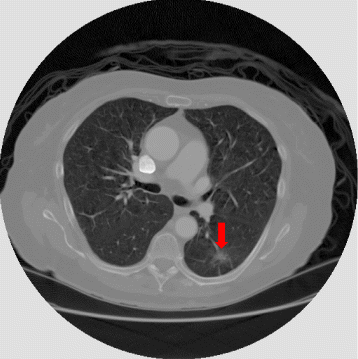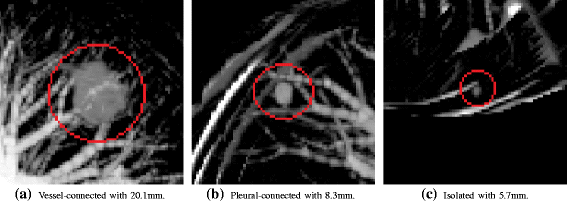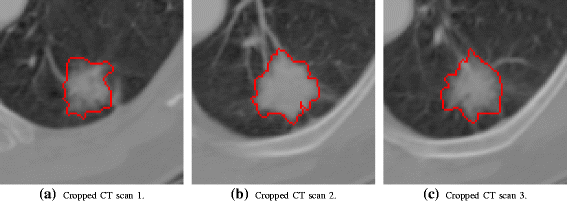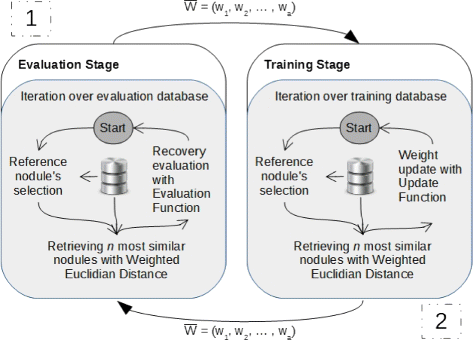Automatic weighing attribute to retrieve similar lung cancer nodules
- PMID: 27460071
- PMCID: PMC4965736
- DOI: 10.1186/s12911-016-0313-4
Automatic weighing attribute to retrieve similar lung cancer nodules
Abstract
Background: Cancer is a disease characterized as an uncontrolled growth of abnormal cells that invades neighboring tissues and destroys them. Lung cancer is the primary cause of cancer-related deaths in the world, and it diagnosis is a complex task for specialists and it presents some big challenges as medical image interpretation process, pulmonary nodule detection and classification. In order to aid specialists in the early diagnosis of lung cancer, computer assistance must be integrated in the imaging interpretation and pulmonary nodule classification processes. Methods of Content-Based Image Retrieval (CBIR) have been described as one promising technique to computer-aided diagnosis and is expected to aid radiologists on image interpretation with a second opinion. However, CBIR presents some limitations: image feature extraction process and appropriate similarity measure. The efficiency of CBIR systems depends on calculating image features that may be relevant to the case similarity analysis. When specialists classify a nodule, they are supported by information from exams, images, etc. But each information has more or less weight over decision making about nodule malignancy. Thus, finding a way to measure the weight allows improvement of image retrieval process through the assignment of higher weights to that attributes that best characterize the nodules.
Methods: In this context, the aim of this work is to present a method to automatically calculate attribute weights based on local learning to reflect the interpretation on image retrieval process. The process consists of two stages that are performed sequentially and cyclically: Evaluation Stage and Training Stage. At each iteration the weights are adjusted according to retrieved nodules. After some iterations, it is possible reach a set of attribute weights that optimize the recovery of similar nodes.
Results: The results achieved by updated weights were promising because was possible increase precision by 10% to 6% on average to retrieve of benign and malignant nodules, respectively, with recall of 25% compared with tests without weights associated to attributes in similarity metric. The best result, we reaching values over 100% of precision average until thirtieth lung cancer nodule retrieved.
Conclusions: Based on the results, WED applied to the three vectors used attributes (3D TA, 3D MSA and InV), with weights adjusted by the process, always achieved better results than those found with ED. With the weights, the Precision was increased on average by 17.3% compared with using ED.
Keywords: Content-based image retrieval; Decision support; Information retrieval; Lung cancer; Update weighing attributes.
Figures








Similar articles
-
Content-Based Image Retrieval System for Pulmonary Nodules: Assisting Radiologists in Self-Learning and Diagnosis of Lung Cancer.J Digit Imaging. 2017 Feb;30(1):63-77. doi: 10.1007/s10278-016-9904-y. J Digit Imaging. 2017. PMID: 27678255 Free PMC article.
-
Content-Based Image Retrieval System for Pulmonary Nodules Using Optimal Feature Sets and Class Membership-Based Retrieval.J Digit Imaging. 2019 Jun;32(3):362-385. doi: 10.1007/s10278-018-0136-1. J Digit Imaging. 2019. PMID: 30361935 Free PMC article.
-
Proposal of Local Automatic Weighing Attribute in CBIR.Stud Health Technol Inform. 2015;216:1020-1. Stud Health Technol Inform. 2015. PMID: 26262321
-
Overview of Computer Aided Detection and Computer Aided Diagnosis Systems for Lung Nodule Detection in Computed Tomography.Curr Med Imaging Rev. 2020;16(1):16-26. doi: 10.2174/1573405615666190206153321. Curr Med Imaging Rev. 2020. PMID: 31989890 Review.
-
A Comprehensive Survey on the Progress, Process, and Challenges of Lung Cancer Detection and Classification.J Healthc Eng. 2022 Dec 16;2022:5905230. doi: 10.1155/2022/5905230. eCollection 2022. J Healthc Eng. 2022. PMID: 36569180 Free PMC article. Review.
Cited by
-
Characterization of Pulmonary Nodules Based on Features of Margin Sharpness and Texture.J Digit Imaging. 2018 Aug;31(4):451-463. doi: 10.1007/s10278-017-0029-8. J Digit Imaging. 2018. PMID: 29047033 Free PMC article. Review.
References
-
- Cintra Lima ICP, Mattos Pimenta CA. Estigma do câncer de pulmão: conceito, fatores associados e avaliação. Investigación en Enfermería: Imagen y Desarrollo. 2015;17:97–112.
-
- Wu H, Sun T, Wang J, Li X, Wang W, Huo D, Lv P, He W, Wang K, Guo X. Combination of radiological and gray level co-occurrence matrix textural features used to distinguish solitary pulmonary nodules by computed tomography. J Digit Imaging. 2013;26(4):797–802. doi: 10.1007/s10278-012-9547-6. - DOI - PMC - PubMed
Publication types
MeSH terms
LinkOut - more resources
Full Text Sources
Other Literature Sources
Medical

